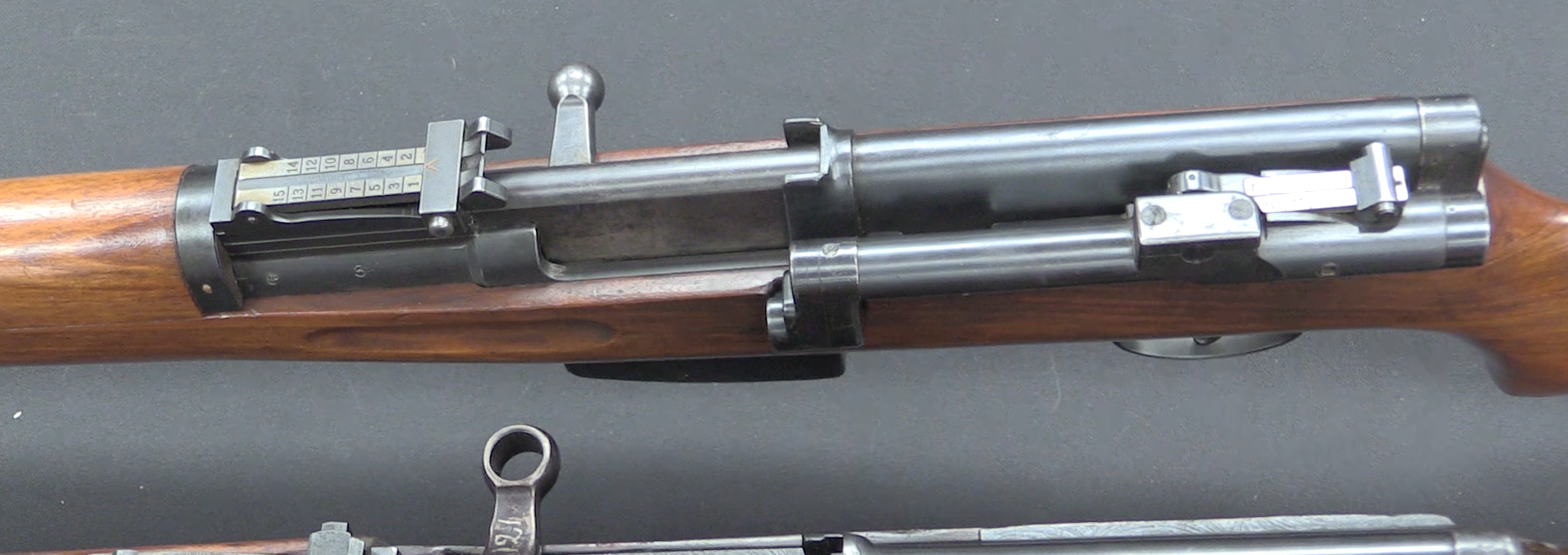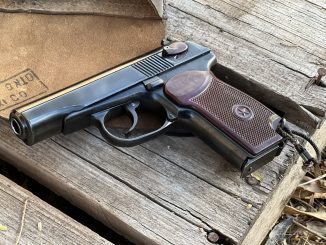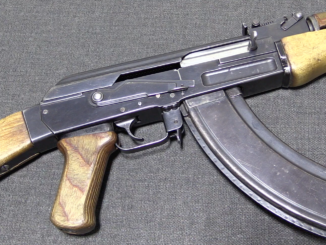Prior to World War Two, the Soviet Union had a rather lackluster interest in antitank rifles – a series of guns were developed, but slowly and without all that much success. The Barbarossa invasion gave a very immediate need for just this sort of weapon, however, to give Soviet infantry units an organic anti-armor capability. Two star Soviet designers were tasked with designing AT rifles, Degtyarev and Simonov. The cartridge they were to use was the new 14.5x114mm, a high-velocity monster using a tungsten carbine cored projectile.
After a shockingly fast development period, the guns from both design bureaus were accepted. The Degtyarev became the PTRD-41, a single-shot auto-ejecting design that was extremely cheap and fast to produce. The Simonov design became the PTRS-41, a 5-shot semiauto offering more firepower but also taking longer to produce. The Degtyarev entered service first, with the first substantial deliveries of PTRS rifles arriving in 1942.
Both designs would serve through the war, with hundreds of thousands being made. Many were put into storage in 1945, and they are still seen today in Ukraine periodically. The PTRS would go on to be the basis for Simonov’s 7.62x39mm infantry rifle, adopted as the SKS.
Many thanks to the Royal Museum of the Armed Forces and Military History in Brussels for access to this very rare piece! Check them out here:
https://www.klm-mra.be/D7t/




Very good to see this, thanks to all. Please someone explain to me: In an SKS, the forward gas piston actually impinges on an intermediate sprung piston, which in turn pushes back on the bolt carrier, which is in turn sprung. This intermediate piston then returns forward (struck by the return of the bolt carrier?), and in turn shoves the gas piston back into its most forward position for the next shot.
1) Is there some name for this two-stage short stroke design? (I would almost call it a tappet but the Williams design has no intermediate part between piston and bolt carrier.) 2) Is it here in the PTRS-41? 3) Was it in the AVS-38 rifle that Simonov cribbed from? 4) Does it exist in any other production firearm? This seems to be such a notable mechanism and hardly any publication I have seen, even the SKS manual in my possession, bothers to explain it. Thanks again.
Meanders of English naming of fire-arms parts naming are definitely too scare for me to wade into, but if you are interesting in Russian names consult Рис. 3. Механизм перезаряжания ружья and following present in manual https://nastavleniya.ru/PTR/ptrs1.html
Well, translation is a problem. Usually, when there is a gas piston, it hits the bolt carrier directly. In the SKS, there is a part in between the piston and the bolt carrier. This resembles a very short piston with a spring. I use the word intermediate meaning in-between. This seems unique to the SKS. Is it? Thank you for link to the reference material.
After examination of the linked manual, it seems that in the PTRS the piston strikes the bolt carrier directly. In this manual, https://www.forgottenweapons.com/wp-content/uploads/2010/12/SKSManual.pdf, page 45 of the .pdf, it is in the diagram part number 20. I can’t copy and paste the Cyrillic but it reads like this: “TORKaTeab.” One of the English-language manuals calls it an “operating rod.” Thank you for your feedback.
The claim that the PTRS-41 is the predecessor of the SKS rifle seems to be not true. The SKS had a lot of predecessors like the SKS-44, SKS-31, SKS-32, SVS-51 and SVS-14 the SVS are dubbed Vintovka meaning rifle instead of the later K for carbine. The SVS-14 was developed in 1938 to compete against the SVT-38 but lost. The SVS-14 was a simplified version of the AVS-38 getting rid of the flapper locking/vertical block combination in favor of the tilting bolt.
37mm K anti-tank rifle https://modernfirearms.net/en/anti-tank-rifles/russia-anti-tank-rifles/kurchevsky-ptr-k/ was officially adopted in 1932, it was withdrawn from service as its’ penetration of 25 mm RHA @ 100 meters was deemed as too weak and it was much heavier (32kg including tripod) in comparison to then developed anti-tank rifles.
Противотанковое ружье Рукавишникова образца 1939 года
https://weaponland.ru/load/protivotankovoe_ruzhe_rukavishnikova_obrazca_1939_goda/145-1-0-846
was officially adopted in 1939, production plan was 50 examples for 1939 year and 15000 examples for 1940 year, but production rate was low due to expectation of enemy tanks to have no less than 60…80 mm of armour and thus rendering this weapon useless.
According to https://ru.wikipedia.org/wiki/14,5_%C3%97_114_%D0%BC%D0%BC
first cartridge to be adopted for service (16 July 1941) with steel core, tungsten carbide cored was adopted later (15 August 1941)
14.5mm was so effective at punching tank side armor, peculiarly between the road wheels, that it prompted the German to add the famous schurzen (side skirts) to try destabilising the 14.5mm Bullets.
“(…)5-shot(…)”
https://www.kalashnikov.ru/pachechnaya-istoriya-ili-o-tom-kak-inogda-ne-veritsya-glazam-svoim/ show photos of clip for PTRS-41 and claims that, despite manual requiring you to always load clip into weapon, in reality – you do not need to do so (it is possible to load cartridge one-by-one into magazine). Examples made in 1942, 1943 and 1944 were tested and they worked with and without clip.
If I am not mistaken, the clip is loaded from the bottom with the magazine open like the french RSC 17
“(…)PTRS would go on to be the basis for Simonov’s 7.62x39mm infantry rifle, adopted as the SKS.(..)”
There is another SKS, which fired 7,62x54R cartridge
https://www.kalashnikov.ru/sks-kotoryj-tak-i-ne-vstupil-v-boj/
In May 1941 two similar design were examined by proving ground: СКС-30 and СКС-31, they differed by magazine design: 10-round clip loaded from bottom (akin to PTRS) and 5-round magazine accepting Mosin rifle’s chargers. Latter was found to be more reliable. Outbreak of war slowed down organization of production of said weapon, small batch was finally procured and tested in actual combat condition, where it was found to be not reliable enough and to have tiring recoil (after firing 50 round soldiers reported pain). 7,62 mm intermediate cartridge proved to be more tame and turned 7,62x54R self-loading rifles no longer much required.
Regarding 2-people nature of PTRS-41 some modern users apparently do not agree with that c.f. https://www.youtube.com/watch?v=TsI3fHUOlQM
That guy is a beast but I am not sure he can actually hit what he is aiming at that way. Even without incoming fire from the tank machine guns or the accompanying infantry.
I remember seing a PTRS alongside a PTRD on a cart in Liège proof house some years ago. The muzzle brake was not that far from the workshop ceiling. But the funniest part were the 2 replica hangonnes that were on same cart. Talk about the techonological gap between those 2 pairs.
Local gun store had one of these on display in the 50-60s. Korean War bring back.
The main reason why the PTRS and PTRD were more effective than the 20×138mmB Lahti L-39 and the Solothurn S18-1000 was not armor penetration in absolute terms, but the fact that the T-34 had thicker side and rear armor than the Panzer III and Panzer IV. The 20×138mmB rifles were plenty effective against early Soviet light and British light and cruiser tanks (the S18-1000 was used by the Italians fairy extensively) such as the T-26, BT-7 and Crusader. Even if the armor penetration of the 20×138mmB rifles had been the same as the Soviet rifles, it still would not have made much difference in practical capability.
There also existed a tungsten-carbide core shot (Panzergranatpatrone 40) in 20×138mmB, but it was never available for the Finnish or Italians, since the Germans reserved the expensive rounds for their Panzer II tanks. Tungsten-carbide core rounds were not manufactured in Italy or Finland (the Italians had a theoretical capability to make them, but expensive and rare tungsten was needed elsewhere.)
Some comments, indexed to run time of the video:
2:06 “the B-32 cartridge”
Actually the B-32 is a style of API (armor-piercing indendiary) projectile with black tip over red stripe, and there were (and still are) 7.62x54R, 12.7×108 and 14.5×114 cartridges loaded with this type of projectile. This is a bare-basic API ammo of the whole Soviet sphere of influence, and for both 12,7 and 14,5 mm HMGs this is considered almost an eqivalent of the LPS ball round. But the B-32 have NEVER contained a tungstene carbide core – the TC-cored bullet in 14.5 caliber was the BS-41 (all-red bullet with black tip and black primer face at the case head). BS in Russian stands for Bronyeboyniy Spetsyalniy (AP Special), not its equivalent in English.
2:54 “40 mm armor @ 300 m”
Hmm. 40 mm is a tad more than 1.5-inch of armor. With a B-32? Good luck. I shot 14.5 mm B-32 a lot with both PTRD, PTRS (admittedly a grand total of perhaps 5 shots with each of these rifles on three different occassions, and PTRS only because I had the en-bloc clip, but I still wince at recalling) and mostly with KPV HMGs (in the guise of PKP, KPVT, ZPU-2 & ZPU-4) against different targets at different distances, down to and incl. 300 meters. Any closer than 500 m was deemed unsafe on hard targets because of fragmentation/ricochet threat, and we were only allowed to shoot turret-mounted KPVT from a BRDM-2 at these that close. It would have penetrated the BRDM or SKOT hull anytime, front or broadside from up to 600 m, BMP-1 @ 300 meters hull side, but front only on a good day, and would just hardly scratch a T-34 vertical hull side @ 300 m (45 mm, Polish postwar T-34-85 M2). With a BS-41? Perhaps, if the armor was made of BS-quality (in English meaning of the term) cast steel. I dunno, never had the opportunity to shoot that ammo at all – it was discontinued after WW2, long before I had opportunity to shoot the weapons. IMHO, a 40 mm RHA is deep into artillery realm, not for kinetic energy rifles, be it as big as that one. Gee, a PzKpfw III had 30 mm FRONT armor until Ausf.G (1941) incl. – but somehow the 1942 PTRD/PTRS field manual lists only ‘lightly armored vehicles’ as likely prey for the ATR and for tank shooting recommends aiming at vision slits, hatches, tracks and other soft spots – MUCH softer than a 40 mm armor plate. Which is BTW, incidentally, a Panther hull side thickness… Color me unconvinced.
5:24 ‘based on the design of the AVS-36 rifle’
AVS? Really? Three-point bolt locking, with vertically sliding lock and stuff? Nope, they are both, PTRS and SKS, tilt-locked.
The SKS/PTRS design path is correct, but neither of these had anything in common with the AVS, except for the person of a designer.
9:40 ‘This is just a mounting’
Actually this is a pivot pin for the missing front carry handle (same as the rear one) allowing two people to carry it assembled in (relative) comfort. The front sight base is pinned to the bbl by the transverse pin visible at the bottom of the front sight base.
Most of time on long marches the PTRS was actually carried disassembled, with one guy hauling the receiver, and the other the bbl with bipod, which were both of almost equal weight, expressly for that purpose. On arriving at the battlefield, the gun was reassembled, and then carried between the firing positions by the two-man crew by carry handles. The similar pivot for the rear handle can be seen in around 11:30, ahead of rear sight. They were both attached to the barrel, BTW.
15:51 ‘also had a hardened steel cored variety… that was the B-41’
Nope, that was the other way around: B-32 was hardened steel API, while hardened steel AP-only was called the B-30 (black tip – quickly discontinued, phased out by the B-32 right at the beginning of the war), and tungstene carbide-cored AP projectile was the BS-41.
The 40mm @ 300m penetration figure is definitely for the BS-41 TC core round and also at 90° (at both planes), that is perpendicular to the armor plate. No one seems to know the quality of the armor plate tested, so one certainly should take it with a grain of salt. Furthermore, getting a perfectly perpendicular hit under field conditions is quite unlikely and therefore 40mm of armor would have provided a pretty good practical protection against the PTRS and PTRD. There is also litte data on how common the BS-41 was in practice, other than it probably was fairly scarce and not available for the majority of engagements. Undoubtedly the production numbers are in some Russian archive, which probably isn’t accessible to Western researchers any longer due the war and embargo…
Penetration with the B-32 hardened steel core API is likely to be at least 25% lower, although it seems to be difficult to find any actual test numbers for it. Without a doubt low enough that medium tanks like Panzer III and Panzer IV would have been quite well protected against fighting compartment penetration even through the sides, which is why the manual tells you to target softer spots on tanks.
Альбом конструкций патронов стрелкового оружия gives following figures
14,5-mm armour-piercing-incendiary bullet pattern 1932 (B-32)
at distance 300 meters, impact angle 70 degree, 20 mm armour is penetrated by 80% of hits
at distance 100 meters, there is 80% chance to set petrol behind 20 mm armour ablaze
Velocity for 14,5-mm bullet with weight of 63,6 g.
Distance (meters) – Velocity (meters per second)
0 – 1012
100 – 961
200 – 911
300 – 862
400 – 815
500 – 768
One more snippet of info:
the PTRS clip was deemed a part of the rifle equipment, unlike the Garand clip – to the point of having a weapon’s serial number applied. Ammunition was issued loose, carried in a special haversack with vertical pockets for perhaps 20 rounds – hence the BS-41 was marked at the primer face – the loader knew what he was handling without having to cast a glance at the bullet tip. BTW, according to the ATR’s FM, BS-41 were considered emergency supply, only used at the commander’s order against high value targets.
My clip was a dug-out, found in the tatters of an empty ammo bag in a trench littered with dozens of 14.5 mm brass cases. These were all fired with a PTRS, because all of these a part of the case rim not exactly bent, but literally dislodged, almost torn away (set back by a full millimeter) by the extractor, and with a ca. 1 mm deep ejector mark. This gives a bit of an understanding what the shooter faced each time he was pulling the trigger 🙂 Small wonder postwar the 14.5 cases were mostly made of lacquered steel, as the brass was way too elastic for that kind of interactions. My guess the site was a training range for the crew/s, as there were literally dozens of cases, perhaps north of 50 of them – far more than I ever came across at a single firing position on a real battlefield.
No Utreon version?
hi there – Ian?
Is it possible or worth doing to compare the two Russian A/tk rifles with the Boys?
TIA
Tim Bailey
PS Any overview of the M60 GPMG there?! I hated it – personally – as did all the Regulars I met as a Marksman & Coach. I was/ am delighted that the US’ soldiers called it ‘the Pig’.
When we got the L4 version of the Bren, until Lithgow began mf’g the MAG58, the regulars got the L4s a few months before us and they LOVED them.
I’m 72 as of last month and no longer serve – but the memory of ‘escorting’ and carrying a jammed M60 to an Armourer in the back of a 6 x6 truck on my own will never go! It was the usual error in the dark – a newby had put the gas-piston in the wrong way round, and bingo!
Sir, if you are looking for M60 hate you have come to precisely the right place. A fellow named Kirk will probably be along shortly to provide a novel-length explanations about each and every aspect of the thing, and why and how he hates each and every one of them
Over to Kirk…
Arnold Wirtgen, first director of Bundeswehr Wehrtechnische Studiensammlung at Koblenz, liked to tell the story that the [cast] turret of the early Leopard prototypes, when the people at Meppen fired a Soviet 14.5 mm antitank rifle at it, was easily penetrated. Which, according to him, caused considerable consternation on the industry side.
Wirtgen was a serious man and I do not doubt that his basic facts were correct.
http://www.tankarchives.ca/2016/07/leopard-armour-schematics.html provides armour thickness of KPz Leopard but with disclaimer that it is GEHEIM observe that thickness of side wall of turret varies, least is 37 mm, maximum is 45 mm, most common is 40 mm, so if they set up AT rifle that strike was perpendicular, distance was low, then it is feasible to get penetrating hit.
We call these weapons anti-tank rifles in English. However, the Russians call them anti-tank guns, the word used is “roozhyo” (it’s the “R” in “PTRS”), not rifle, which would be “vintokvka”.
Is this significant? We would use the term “gun” for an artillery piece, which is what these weapons verge upon. They are far more powerful than anything we would usually term a rifle.